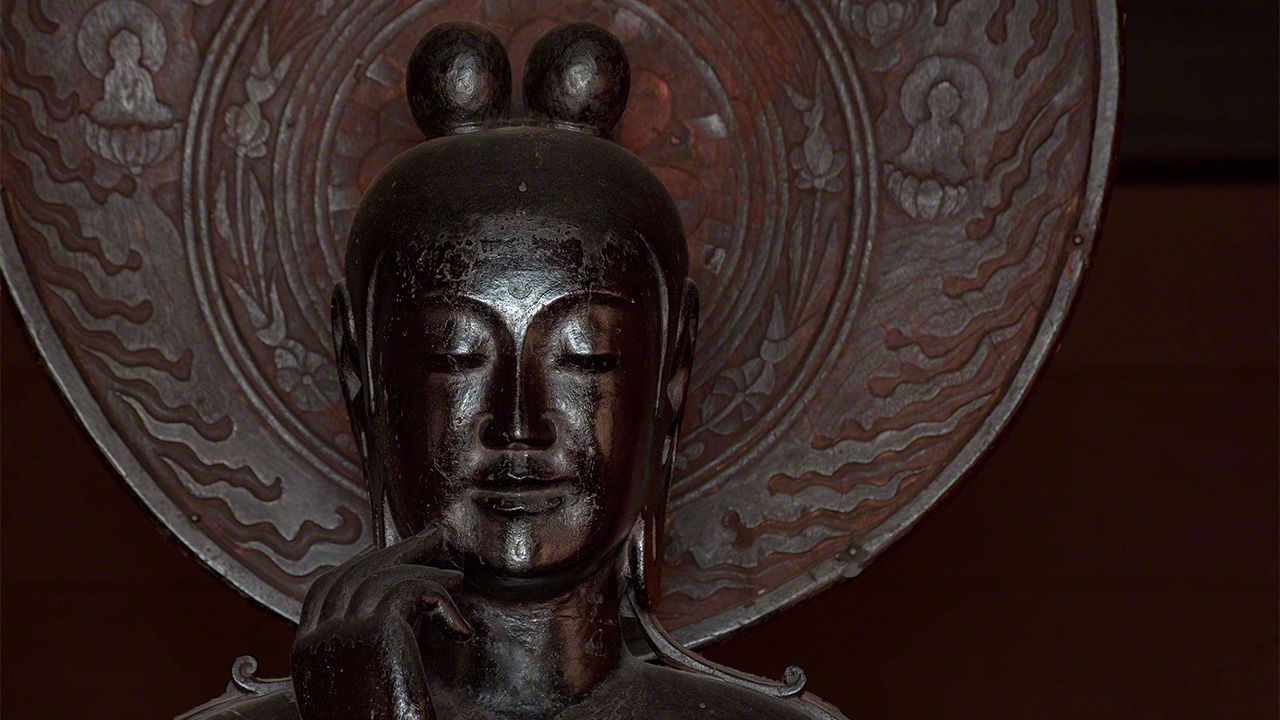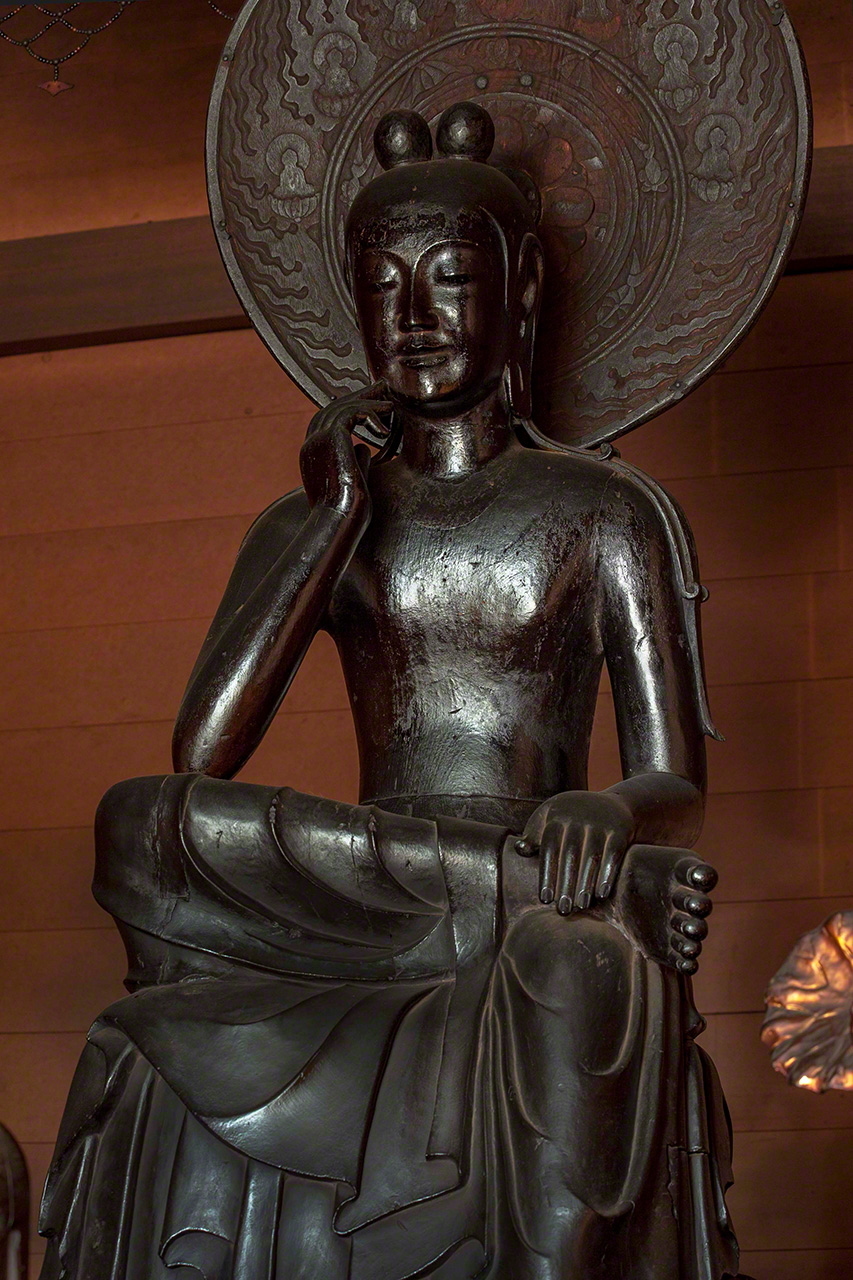
Image of a Bodhisattva in Half-Lotus Position
Culture Arts- English
- 日本語
- 简体字
- 繁體字
- Français
- Español
- العربية
- Русский
There is something truly bracing about an encounter with this fine-featured face and its profound smile of compassion.
This depiction of a bodhisattva is the main image at Chūgūji, a temple in Ikaruga, Nara Prefecture. The site was originally a nunnery apparently built for Anahobe no Hashihito, the mother of Shōtoku Taishi, the prince who was one of the most important patrons of early Japanese Buddhism. Along with the celebrated Hōryūji, Chūgūji is one of seven temples attributed to him. Since the end of the sixteenth century, it has stood adjacent to the eastern precinct of Hōryūji, but its original location was some 500 meters farther to the east. An archeological survey carried out at the old site during the twentieth century unearthed large numbers of the same kind of tiles used at Hōryūji. It is likely that this image was worshipped as Chūgūji’s primary image as early as the Asuka period (593–710).
The bodhisattva in the image belongs to a type known as hanka-shii. He is seated in half-lotus position (hanka), one leg raised over the other, holding a hand to his cheek in contemplation (shii), perhaps considering how best to bring salvation to the people of the world. Temple records describe the image as a statue of Nyoirin Kannon (Cintamanicakra), a manifestation of the Kannon bodhisattva (Avalokiteshvara). However, a similar image (also in hanka-shii pose) at Yachūji in Osaka Prefecture carries an inscription on its dais identifying the bodhisattva as Miroku (Maitreya), the Buddha of the Future. Many scholars therefore believe that statues made in this style in Japan were intended as depictions of the latter. It remains something of a mystery why tradition should have identified this particular example as Nyoirin Kannon instead.

(© Muda Tomohiro)
There are a number of theories about when the statue might have been produced, ranging from the reign of Empress Suiko (554–628) to that of Empress Jitō (645–702), but most scholars agree that the image probably dates from around 650. The smile and other features bear no hint of stiffness, and mark a further step in development from the “archaic smile” characteristic of many sculptures of the early Asuka period toward a more naturalistic and expressive style. The contours of the robes are further evidence—instead of simply hanging down in symmetrical lines on both sides like the robes in many earlier sculptures, they are much more freely cast and more evocative of natural movement. Based on these factors, scholars believe that the image dates from the late Asuka period, otherwise known as the Hakuhō period.
The statue was made from camphor (kusunoki), considered a sacred tree, using the yosegi-zukuri, in which two or more pieces of wood are combined to form the main part of the image. Each part was carefully finished and then combined to produce an effect of astonishingly delicateness and beauty. The shiny matte-black of the body makes the statue look as if it were made of steel. Research has shown that the surface was coated with sabi-urushi, a paste-like mixture combining raw lacquer with tonoko powder, made from clay soil. A layer of white clay was applied over this, followed by further coloring.
It is thought that the mo robes of the bodhisattva would originally have been vermilion, and that the fabric on the pedestal would have been decorated using kirikane, a technique in which a thin sheet of metal is cut into small pieces, which are then affixed to a surface to form a pattern, and verdigris, while the halo-like aureola behind the bodhisattva’s head would have glistened with gold. Small holes are present in the head and arms of the image, suggesting that the bodhisattva originally wore a crown, bracelets and other luxury adornments. It is easy to imagine that this was once an exceptionally vividly colored image.
Although a small trace of the original flesh pigmentation survives on the sole of the right foot, the rest of this color has been lost over the course of the 1,300-plus years since the statue was made. There are several theories about the statue’s current glossy black appearance. Some people believe the sabi-urushi of the original was gradually “smoked” black from the soot of the oil lamps that would have provided a dim light to the temple halls, while others believe that additional layers of black lacquer were painted on at a later date. The true explanation remains unclear.

(© Muda Tomohiro)
Not that the bodhisattva himself seems to care especially about such matters. His timeless smile almost seems to smile with gentle mockery at the misguided questions of the profane world.
Image of a Bodhisattva in Half-Lotus Position (traditionally identified as Nyoirin Kannon)
- Height: 132 cm
- Date: Asuka period (593–710)
- Chūgūji, Nara Prefecture (visitors wishing to view it should confirm whether it is on display in advance)
- National Treasure
(Originally published in Japanese. Banner photo: Seated image of a bodhisattva in half-lotus position at the temple Chūgūji. © Muda Tomohiro.)
